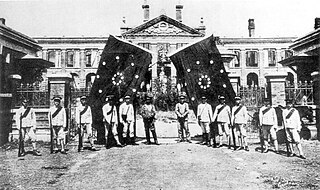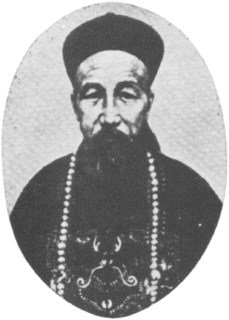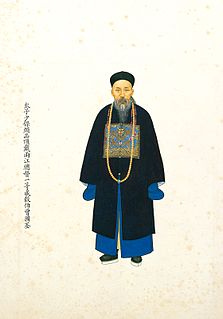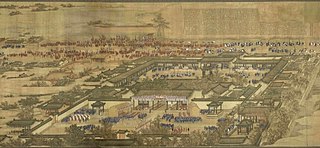
The Taiping Rebellion, also known as the Taiping Civil War or the Taiping Revolution, was a massive rebellion or total civil war in China that was waged from 1850 to 1864 between the established Manchu-led Qing dynasty and the Taiping Heavenly Kingdom under Hong Xiuquan.

The Wuchang Uprising was an armed rebellion against the ruling Qing dynasty that took place in Wuchang, Hubei, China on October 10, 1911, which was the beginning of the Xinhai Revolution that successfully overthrew China's last imperial dynasty. It was led by elements of the New Army, influenced by revolutionary ideas from Tongmenghui. The uprising and the eventual revolution directly led to the downfall of the Qing dynasty with five millennia of imperial rule, and the establishment of the Republic of China (ROC), which commemorates the anniversary of the uprising's starting date of 10th October as the National Day of the Republic of China.

Zeng Guofan, Marquis Yiyong, birth name Zeng Zicheng, courtesy name Bohan, was a Chinese statesman, military general, and Confucian scholar of the late Qing dynasty. He is best known for raising and organizing the Xiang Army to aid the Qing military in suppressing the Taiping Rebellion and restoring the stability of the Qing Empire. Along with other prominent figures such as Zuo Zongtang and Li Hongzhang of his time, Zeng set the scene for the Tongzhi Restoration, an attempt to arrest the decline of the Qing dynasty. Zeng was known for his strategic perception, administrative skill and noble personality on Confucianist practice, but also for the ruthlessness of his repression of rebellions. He exemplified loyalty in an era of chaos, but is also regarded as laying the foundation to the rise of modern warlordism in China. William T. Rowe describes him as the "de facto representative of Qing control in most of central and south China" during the 1850's and 60's.
Zhang Xianzhong or Chang Hsien-chung, nicknamed Yellow Tiger, was a leader of a peasant revolt from Yan'an, Shaanxi Province. He conquered Sichuan in 1644, and named himself king of the Xi (Da-Xi) dynasty. His rule in Sichuan was brief and he was killed by the invading Manchu army. He is commonly associated with the massacres in Sichuan that depopulated the region. However, the extent of his killings is disputed.

The Xiang Army or Hunan Army was a standing army organized by Zeng Guofan from existing regional and village militia forces called tuanlian to contain the Taiping Rebellion in Qing China. The name is taken from the Hunan region where the Army was raised. The Army was financed through local nobles and gentry, as opposed to through the centralized Manchu-led Qing dynasty. The army was mostly disbanded by Zeng after the re-capture of the Taiping capital at Nanking.

Zeng Guoquan, courtesy name Yuanfu, art name Shuchun, was a Chinese official and military leader of the late Qing dynasty. He was the ninth brother of Zeng Guofan, a prominent statesman and general, and a descendant of the philosopher Zengzi. He served in the Xiang Army, a standing military force organised by his brother to counter the Taiping rebels, and was nicknamed "Ninth Marshal" (九帥). He was known for his expertise in siege warfare, particularly the use of trenches, hence he was also nicknamed "Zeng the Iron Container" (曾鐵桶). During the conquest of Tianjing (Nanjing), the capital of the Taiping Heavenly Kingdom, Zeng was notorious for condoning massacres of the city populace, which resulted in him being called "Zeng the Butcher" (曾屠戶).
Ma Xinyi ( Xiao'erjing: ﻣَﺎ سٍ ىِ, traditional Chinese: 馬新貽; simplified Chinese: 马新贻; pinyin: Mǎ Xīnyí; Wade–Giles: Ma Hsin-I; Styled and variably 穀三 ; Posthumous title: 端敏公 ; was an eminent Hui Muslim official and a military general of the late Qing Dynasty in China.
Jiangnan DaYing (Chinese: 江南大營 or the Army Group Jiangnan; was an army group assembled by the Qing dynasty. The army group consist of mostly Green Standard Army, and their goal was to quell the Taiping Rebellion around the Jiangnan region. The army group twice encircled Nanjing, the capital of the Taiping Heavenly Kingdom, but were defeated by the Taiping forces on both occasions.

Luo Bingzhang (Chinese: 駱秉章, courtesy names Yumen 籲門 and Ruzhai 儒齋; Posthumous name: Wenzhong 文忠; was an eminent Han Chinese official, military general, and devout Confucian scholar of the late Qing Dynasty in China.
The Battle of Guanzhong (關中攻防戰) occurred during the Taiping Revolution that took place in November 1861. When Taiping's Western Army was defeated at Wuhan, they lost their connection with their capital of Nanjing. Former Western Army Commander Chen Yucheng then decided to resupply at Guanzhong. Some of their soldiers were troops who once fought for the Nien Rebellion, so Yucheng decided not to provide them with supplies, as he was uncertain of their loyalty.

The Taiping Heavenly Kingdom, officially the Heavenly Kingdom of Great Peace, was an oppositional state in China from 1851 to 1864, supporting the overthrow of the Qing dynasty by Hong Xiuquan and his followers. The unsuccessful war it waged against the Qing is known as the Taiping Rebellion. Its capital was at Tianjing.
Ye Yunlai was a military leader of the Taiping Rebellion. He began his military career in the Jintian Uprising, later becoming a general, leading Taiping forces to many military victories. He was the chief commander defending Anqing city and never surrendered, ultimately dying in battle. He was awarded the E An in 1857.

The Railway Protection Movement, also known as the "Railway Rights Protection Movement", was a political protest movement that erupted in 1911 in late Qing China against the Qing government's plan to nationalize local railway development projects and transfer control to foreign banks. The movement, centered in Sichuan province, expressed mass discontent with Qing rule, galvanized anti-Qing groups and contributed to the outbreak of the Xinhai Revolution. The mobilization of imperial troops from neighboring Hubei Province to suppress the Railway Protection Movement created the opportunity for revolutionaries in Wuhan to launch the Wuchang Uprising, which triggered the revolution that overthrew the Qing dynasty and established the Republic of China.

Duanfang, courtesy name Wuqiao, was a Manchu politician, educator and collector who lived in the late Qing dynasty. He was a member of the Tohoro clan and the Plain White Banner of the Eight Banners.

Feng Guifen was a scholar during the Qing Dynasty and was a strong contributor to the philosophy of the Self-Strengthening Movement undertaken in the late 19th century. Feng is known for his interest in techniques by which states had become wealthy and strong, highlighting these subjects in the essay he wrote to propose reforms for the Chinese empire.

The Red Turban Rebellion of 1854–1856, sometimes known as the Red Turban Revolt and by some as just the Taiping Rebellion in Guangdong, was a series of uprisings by members of the Tiandihui or Heaven and Earth Society (天地會) in the Guangdong province of South China.
The Battle of Anqing (安慶之戰) was a prolonged siege of the prefecture-level city of Anqing in Anhui, China, initiated by Hunan Army forces loyal to the Qing Dynasty against the armies of the Taiping Heavenly Kingdom. The siege began in September 1860 and ended on September 5, 1861, when imperial forces under the command of Zeng Guoquan breached the walls of the city and occupied it.
The Western Expedition was a campaign by the Taiping Heavenly Kingdom against the Qing dynasty during the Taiping Rebellion.

The Battle of Wuchang occurred in 1852 during the Taiping Rebellion in Wuchang, part of the modern-day city of Wuhan.
















